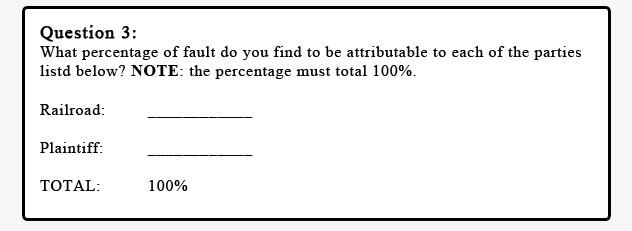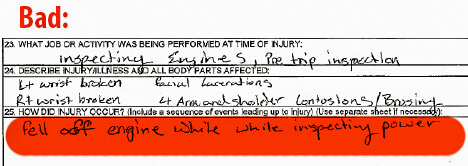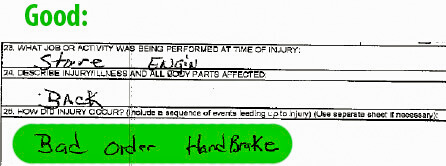How to Fill Out Your KCS 68E Injury Report
Your KCS Injury Report is Key to Winning Your FELA Injury Case
Negligence is the most hotly contested issue in an FELA/railroad injury case. Once an injury occurs, the railroad’s legal team quietly sets out to prove that it wasn’t the railroad’s fault that you got hurt and/or that it was your fault and you negligently caused your own injury.
Why? Because the railroad only has to pay your FELA claim if the railroad was at fault. And even if the railroad is at fault, its liability for damages can still be reduced by the percentage of contributory negligence that they can pin on the injured worker.
Take a look at how the question usually looks on a jury form in an FELA case:

How to fill out an injury report to prove the railroad negligent:
Tell the Truth! Don’t just tell the railroad managers or claim agents what you think they want you to say.
When you report your on the job injury you will be asked to fill out a form KCS-68-E – Employee Report of Injury and Illness. To protect your case, use this form to report any and all unsafe conditions that contributed to your injury.
Some common unsafe conditions that railroaders deal with almost every day that lead to injuries are:
- Defective handholds
- Trackside vegetation
- Oil on locomotive floor
- Oil in yard especially near roundhouse
- Muddy ballast
- Bad lighting
- RCO malfunction
- Co-worker gives improper car counts during a shove or fails to follow radio rules
- Hand brake malfunctions
- Defective switches that are hard to throw
Some of the conditions above are so common that you probably won’t even think of them as being the least bit unusual. Many of them will have been previously reported, even several times, but instead of fixing them the railroad simply adds them to their track bulletins for months or even years.
Whatever the case, if a dangerous condition or defect contributes to you getting hurt, IT IS VITAL THAT YOU REPORT IT ON YOUR FORM 68-E. Use question number 25, “How Did Injury Occur” to explain any and all unsafe conditions that contributed to or caused your injury.
Here are some good and bad examples of answers to this question from actual cases:

The above employee missed his chance to explain that oily, slippery conditions in the yard and poor lighting caused him to fall.

This injured employee quickly described the dangerous defect that led to his injury. Clearly, someone else at the railroad was at fault for the injury he suffered.
Here are a few notes on other important areas of the KCS 68-E.
21 Weather Conditions:
Keep in mind that weather conditions may often contribute to a railroad injury. For instance, rain may spread an oily condition around making it that much harder to avoid. Accurately report the weather conditions here and if necessary use question 25 to explain how they contributed to your injury.
22 Visibility:
Many injured workers don’t immediately realize that visibility is an issue in their case. Low light can make it difficult to see dangerous conditions that could otherwise be avoided. Report any issues with lighting such as burned out bulbs here and/or use question 25 to explain.
26 Car and Engine Numbers:
Obviously, it is important to report the car numbers or engine number if any defective equipment is involved. Doing so should lead to an inspection, which can result in photographs of the defect and help to prove that you were not at fault for your own injury.
29 and 30 Crew Members and Witnesses:
A witness doesn’t necessarily have to see the injury happen. List all of your crewmembers and anyone else who may have knowledge of any defects or dangerous conditions that led to your injury. If possible, get contact information for any non-kcs witnesses like van driver’s etc… Such witnesses are often hard to locate later.
Consult with an expert!
As mentioned above – the railroad’s legal team springs into action immediately following an injury with one goal: to reduce the value of your claim.
If you suffer an injury, you need to have your own team of experts. Consult your union representative or a veteran employee and/or call an FELA attorney as soon as possible. We are happy to advise you.


Leave A Comment